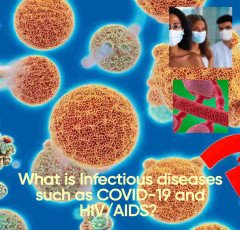
What is Infectious diseases such as COVID-19 and HIV/AIDS ?

Microorganisms like bacteria, viruses, fungi, and parasites that enter the body and reproduce are what cause infectious diseases.
Through direct or indirect contact, such as through respiratory droplets, sexual contact, tainted food or water, or exposure to infectious bodily fluids, many diseases can transmit from one person to another.
The SARS-CoV-2 virus, which causes COVID-19, spreads through respiratory droplets when an infected person talks, coughs, or sneezes.
Additionally, contacting contaminated surfaces before touching one's face can spread the infection.
The HIV (Human Immunodeficiency Virus) virus targets CD4 cells, which are essential for the body's defense against infections. Unprotected sexual contact, sharing of needles or syringes, and mother-to-child transmission during pregnancy, childbirth, or breastfeeding are the main ways that HIV is transferred.
HIV/AIDS and COVID-19 are both infectious diseases brought on by many virus types, but they differ in their means of transmission, signs and symptoms, and approaches to therapy. Unlike HIV, which has been around since the 1980s, COVID-19 is a brand-new virus that surfaced in late 2019. While COVID-19 presently has numerous approved medicines and vaccinations, HIV has effective treatments but no cure.
Fever, cough, shortness of breath, exhaustion, body aches, loss of taste or smell, sore throat, and headache are some of the signs and symptoms of COVID-19. COVID-19 can occasionally induce serious respiratory disease that necessitates hospitalization or even results in death.
Although the majority of COVID-19 patients recover without the need for special care, some may endure long-term symptoms or consequences.
HIV symptoms may not manifest for years after someone becomes infected. Fever, weariness, swollen lymph nodes, a sore throat, rash, and muscle aches are some of the symptoms that may show up. HIV impairs the immune system, making those who have it more susceptible to other infections and several cancers.
Using condoms when having sex, avoiding sharing needles or syringes, washing hands frequently, covering coughs and sneezes, and being immunized when accessible are all examples of excellent hygiene and COVID-19 and HIV/AIDS prevention strategies.
HIV/AIDS and COVID-19 are two distinct diseases brought on by two distinct viruses, yet they are both dangerous infectious diseases that call for careful consideration in both prevention and therapy. It's critical to stay up to date on the latest advancements in the diagnosis, screening, and treatment of these two diseases.
There are a number of COVID-19 vaccinations that have been authorized and are proven to be both safe and efficient in avoiding COVID-19 infection and serious disease. Although there are drugs that can be taken to treat the virus and slow its spread, HIV vaccines are currently being developed and are not yet accessible.
Treatments for COVID-19 other than immunizations include steroids, monoclonal antibodies, and antiviral drugs. Antiretroviral therapy (ART), which entails taking a mix of drugs that target several phases of the virus' life cycle, is the conventional treatment for HIV.
The COVID-19 pandemic has brought attention to the value of readiness and international collaboration in combating infectious diseases.
Additionally, it has highlighted the necessity of effective public health systems, equitable resource distribution, and access to healthcare.
Microorganisms are the root cause of infectious diseases like COVID-19 and HIV/AIDS that can transmit from person to person via a variety of channels.
Utilizing accessible treatments, being vaccinated, practicing basic hygiene, and engaging in safe sexual activity are among preventative methods that can lessen the impact that these illnesses have on both individuals and communities.
In addition to the effects on physical health, infectious diseases can have considerable negative social and economic effects.
Infectious disease outbreaks can cause societal unrest, financial hardship, and stress on healthcare infrastructure. In order to stop the transmission of contagious diseases, measures like lockdowns, travel restrictions, and social isolation may be necessary.
However, they may also have unfavorable effects on people and communities.
Vulnerable populations, such as individuals with underlying medical issues, low-income areas, and marginalized groups, might be disproportionately affected by infectious diseases. In order to lessen the burden of infectious illnesses and promote health and welfare for all, it is crucial to address health disparities and provide fair access to preventative and therapeutic measures.
It is crucial to remember that infectious diseases are a persistent problem and that new pathogens can appear at any time.
Investing in research and development, bolstering public health systems, and responding to outbreaks are crucial parts of the global effort to prevent and control infectious illnesses.
Technology advancements have been crucial in the fight against infectious illnesses.
To promptly identify infections and monitor the development of disease, for instance, rapid diagnostic procedures like PCR and antigen testing have been created. In order to provide care and assistance to patients without placing them at danger of infection, healthcare providers are increasingly using telemedicine and remote monitoring.
Artificial intelligence and data analytics are also being used to track and forecast disease outbreaks, assess the efficiency of preventative and therapeutic interventions, and guide public health policies and decision-making.
A coordinated, multidisciplinary strategy including public health officials, healthcare professionals, researchers, policymakers, and the general public is needed to address the persistent problem of infectious illnesses. Together, we can continue to make strides in the diagnosis, treatment, and management of infectious diseases, enhancing everyone's health and welfare.
The COVID-19 pandemic has taught us several important lessons, one of which is the value of international cooperation and teamwork in combating infectious diseases. The epidemic has brought to light the necessity for nations to collaborate in order to exchange knowledge, resources, and skills in order to stop the spread of disease and safeguard public health.
The World Health Organization (WHO) is essential in organizing the international response to infectious diseases, offering technical advice, and encouraging research and development. The World Health Organization also collaborates closely with other institutions like UNICEF and the World Bank to guarantee a coordinated response to global health issues.
The Global Fund to Fight AIDS, Tuberculosis, and Malaria, the Bill and Melinda Gates Foundation, and the Coalition for Epidemic Preparedness Innovations (CEPI), among many others, strive to combat infectious diseases in addition to the WHO.
Infectious diseases will undoubtedly continue to represent a serious threat to the world's health and well-being in the future.
Ongoing To overcome these issues, research, development, and innovation spending are essential.
This entails improving public health infrastructure and processes, as well as creating novel drugs, vaccines, and diagnostic tools.
Prioritizing health equity and making preventative and treatment options available and affordable for everyone are also imperative.
This includes dealing with the underlying factors that contribute to health disparities, such as poverty, prejudice, and a lack of access to healthcare.
Education and public awareness are essential for halting the spread of contagious diseases.
People and communities can take action to safeguard their health and wellbeing by receiving correct information and clear communication on preventative and treatment methods.
Infectious diseases like COVID-19 and HIV/AIDS continue to pose serious threats to the world's health and well-being. However, we can continue to advance in the prevention, treatment, and control of these diseases and promote health and wellbeing for all with continuous investments in research and development, international cooperation and collaboration, and a commitment to health equity.

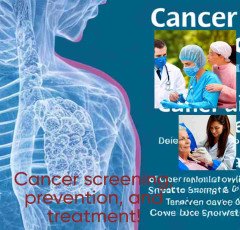
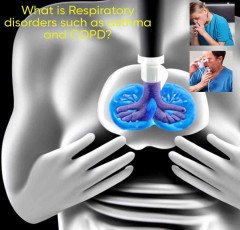

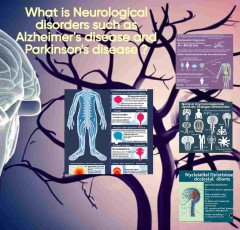
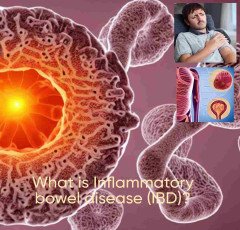
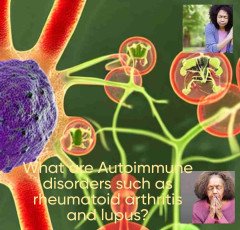







 Only For The United States
Only For The United States  Motion Sensor Light
Motion Sensor Light  Adidas Shoes
Adidas Shoes  Best Selling Books
Best Selling Books  Artificial Intelligence
Artificial Intelligence  The Click Engine
The Click Engine  HP Laptop
HP Laptop  SOFAS
SOFAS  Top Rated From Amazon
Top Rated From Amazon  4k Projector For Home
4k Projector For Home  Creative Brief For Video Shoot
Creative Brief For Video Shoot  SEO Checklist
SEO Checklist  The Secret Email System
The Secret Email System  ASPINAL LONDON
ASPINAL LONDON  Favorite Company (Cuelinks)
Favorite Company (Cuelinks)  Puma (Clothing & Accessories)
Puma (Clothing & Accessories)  Rakhi
Rakhi  Healthy Ingredients
Healthy Ingredients  Hello Theme
Hello Theme  Hanging Lights For Living Room
Hanging Lights For Living Room  Apple iPhone
Apple iPhone  Wireless Gaming Mouse
Wireless Gaming Mouse  Samsung Mobile
Samsung Mobile  Smart Watches
Smart Watches  Smart Doorbell
Smart Doorbell  iPhone cable
iPhone cable  Online Technology Classes
Online Technology Classes  Unreal Engine 5 For Beginners Learn The Basics Of Virtual Production
Unreal Engine 5 For Beginners Learn The Basics Of Virtual Production  Home Decor Items
Home Decor Items  Essentials for Gamers
Essentials for Gamers  Best Robotic Vacuum Cleaners
Best Robotic Vacuum Cleaners  Best Sellers On Amazon
Best Sellers On Amazon  NordLocker
NordLocker  Kitchen Tap
Kitchen Tap  NordPass
NordPass  Sennheiser
Sennheiser  Men Clothing
Men Clothing  Air Purifier for Home
Air Purifier for Home  Digital Voice Recorder
Digital Voice Recorder  Echo Dot - Smart speaker with Alexa
Echo Dot - Smart speaker with Alexa  Crocs
Crocs  Bathroom Mirrors
Bathroom Mirrors  Dell Laptop
Dell Laptop  Graphics & Design
Graphics & Design  1150+Trendy kids coloring pages Bundle
1150+Trendy kids coloring pages Bundle  Online Marketing
Online Marketing  Wireless Bluetooth Earphones
Wireless Bluetooth Earphones  Wall Lamp
Wall Lamp  NordVPN
NordVPN  ASUS Laptop
ASUS Laptop  BEST SELLER TOP10
BEST SELLER TOP10  One World Collection
One World Collection  Dual USB Car Charger
Dual USB Car Charger  LCD Writing Tablet
LCD Writing Tablet  Prime Video
Prime Video  Amazon Best Selling Products
Amazon Best Selling Products  TitTok Revolution
TitTok Revolution  Unlimited access to classes on illustration, photography, design, film, music
Unlimited access to classes on illustration, photography, design, film, music  Realme Smart Phone
Realme Smart Phone  Acer Laptop
Acer Laptop  Best Home Appliances
Best Home Appliances  ELECTRONIC ACCESSORIES
ELECTRONIC ACCESSORIES  RPM 3.0
RPM 3.0 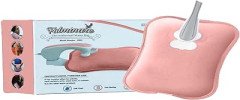 Hot Bags For Pain Relief
Hot Bags For Pain Relief  Wristbands
Wristbands  Stylish Sneakers by Red Tape
Stylish Sneakers by Red Tape  All Wireless Products
All Wireless Products  Women Fashion
Women Fashion  Door Handle Collection
Door Handle Collection  Duke T Shirts
Duke T Shirts  Kitchen Daily Use
Kitchen Daily Use  Best Phone
Best Phone  Pet Care Products
Pet Care Products 


















